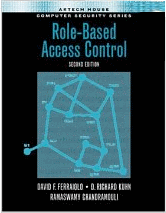Try the new CSRC.nist.gov and let us know what you think!
(Note: Beta site content may not be complete.)

 RBAC book |
"A must read." Review from IEEE Computer Society, Security & Privacy "Overall, this is a great book." Linux Journal |
 |
2002 Gold Medal for Scientific/ Engineering Achievement - US Department |
 |
1998 Excellence in Technology Transfer Award - Federal Laboratory Consortium |
 |
1998 Best Paper - Nat Inf Systems Security Conf |
Role-Based Access Control
ISBN 1-58053-370-1
David F. Ferraiolo, D. Richard Kuhn, and Ramaswamy Chandramouli
338 pages
Role-based access control (RBAC) is a security mechanism that can greatly lower the cost and complexity of security administration for large networked applications. RBAC simplifies security administration by using roles, hierarchies, and constraints to organize privileges. This book explains these components of RBAC, as well as how to support and administer RBAC in a networked environment and how to integrate it with existing infrastructure.
Because role hierarchies and role engineering are crucial to RBAC, you learn how to effectively implement them to ensure total access control. Specialized topics covered in detail include separation of duties, combining RBAC with military security models, and recent efforts toward standardization. This book also guides you through the various RBAC products available on the market and along the migration path to deploying RBAC for enterprise-wide security.
Read a review of the book from IEEE Computer Society Security & Privacy T.C.'s Cipher
Contents:- Introduction - Purpose and Fundamental of Access Control. Authorization Management and Access Control. Administration and Scalability Issues. Access Control Policies, Models, and Mechanisms. Brief History of Access Controls. Origins of Role-Based Access Controls (RBACs).
- Access Control Methods - Access Control Matrix. Discretionary Access Control. Lattice Based Models. Mandatory Access Control. Domain Type Enforcements. Clark-Wilson. Chinese Wall.
- Overview of RBAC - Roles v. Groups. Users, Roles, and Permissions. User/Role Assignments. Role/Permission Assignments. Role Hierarchies. Static Constraints. Session Management. Dynamic Constraints. Cost, Policy, and Administrative Benefits.
- Role Hierarchies - Inheritance. Limited Hierarchies. General Hierarchies.
- Separation of Duty Policies - Static Separation of Duty Policies. Dynamic Separation of Duty Policies. History-Based Separation of Duty Policies.
- Using RBAC to Implement Military Policies - Implementing Multi-Level Security (MLS) Models with RBAC. Implementing Discretionary Access Control with RBAC. Implementing RBAC with MLS. Operation RBAC and MLS Policies Simultaneously.
- Standard RBAC - Proposed NIST Standard. Common Criteria RBAC Protection Profile. Standards Conformance Issues.
- RBAC Administration - Administrative Roles. Administrative Capabilities. Delegation.
- Integrating RBAC with Existing Infrastructure - XML Schemas and Related Models for RBAC. RBAC Implementation in a PKI Environment.
- Research Prototypes - RBAC/Web. Role Control Center.
- Commercial RBAC Products - SUN Solaris. Sybase SQL Server. BMC INCONTROL for Security Management. Sysor Security Administration Manager. Tivoli TME Security Management. Computer Associates Protect IT. Siemens rbacDirX.
- Migrating to RBAC - Determining Roles and Role Hierarchies from Existing Access Control Structures. Top Down and Bottom Up Approach. User/Role Ratios. Role Engineering Tools.